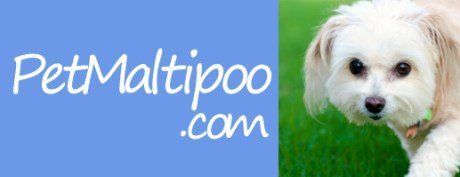The Toy Poodle VS the Maltipoo
Interesting Differences Between Maltipoo Dogs and Toy Poodles
When you have a hybrid dog, it’s always interesting to look at the stats of the contributing breeds, which for the Maltipoo is the toy Poodle (though in some cases a mini Poodle) and the Maltese. However, it can also be eye-opening to see the Maltipoo compared side-by-side with each purebred. For this reason, you may wish to also refer to the
Maltipoo VS Maltese
section and here we will go into the details of a Maltipoo VS a toy Poodle.
We will cover:
• Differences in purebred vs hybrid status
• Side-by-site stats
• Differences and similarities in coat, color, size and more
• Breed specific health issues
• Grooming requirements
• Care overviews
Please note:
PetMaltipoo is reader-supported. Some of the product suggestions on this page are affiliate links. As an Amazon Associate we earn from qualifying purchases. This is at no extra cost to you and helps us continue creating useful content.
Interesting Differences Between Maltipoo Dogs and Toy Poodles
When you have a hybrid dog, it’s always interesting to look at the stats of the contributing breeds, which for the Maltipoo is the toy Poodle (though in some cases a mini Poodle) and the Maltese. However, it can also be eye-opening to see the Maltipoo compared side-by-side with each purebred. For this reason, you may wish to also refer to the Maltipoo VS Maltese
section and here we will go into the details of a Maltipoo VS a toy Poodle.
We will cover:
• Differences in purebred vs hybrid status
• Side-by-site stats
• Differences and similarities in coat, color, size and more
• Breed specific health issues
• Grooming requirements
• Care overviews
Toy Poodle VS Maltipoo - Purebred Vs Hybrid
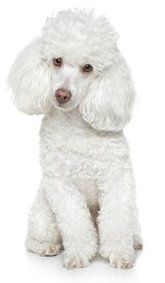
Toy Poodle
Toy Poodle
- The toy Poodle is a purebred, accepted into the AKC in 1887, along with the mini and standard, as all are considered to be 1 breed that is separated into 3 varieties, with the toy being the smallest. The FCI recognizes 4 sizes, with the forth being the ‘medium’, which still has the toy being the smallest of all. It is interesting to note that there used to be different AKC breed standards for each Poodle size. The toy Poodle standard was written in 1938. In 1940, they were written for the mini and standard. Then, in the 1950’s all 3 were combined into one.
One of the main distinctions of being a purebred is that there is a very strict standard of appearance with very little deviation. A purebred has a proven lineage. Each dog is a descendant of proven purebreds.
Aside from very poor breeding practices, every toy Poodle is going to look very similar to the next, excluding coat color, of course, unlike the Maltipoo that has yet to be have a reliable consistent appearance (though we are slowly getting there). With the Poodle, the coat is always curly, the eyes always dark. Yet, it goes much deeper than this. Everything is defined to exacting measures. For example, per AKC guidelines, “The shoulder blade is well laid back and approximately the same length as the upper foreleg”. Even the way in which the dog walks is standardized, “A straightforward trot with light springy action and strong hindquarters drive”.
And in addition, size is consistent as well. All toy Poodles will be 10 inches or less from the withers (top of shoulder blades) to the floor.
So, while toy Poodles will vary in color, a toy Poodle will never be mistaken for any other breed or a mixed breed. He will also have a distinguishing look that is reliable throughout generations.
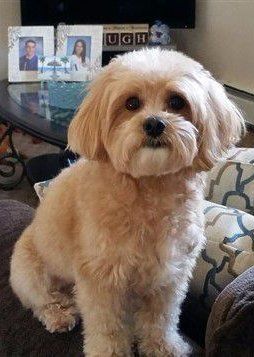
Maltipoo: Bailey at 3 years old. Photo courtesy of Jean & Maurice
Maltipoos
- The Maltipoo is known as a hybrid or designer dog. It’s interesting to note that the word hybrid is technically used incorrectly when describing canines, as it actually refers to the crossing of two genetically distinct individuals; for example, a cross between a puma and a leopard, which gives us the Pumapard. Though, since this term is overwhelmingly used, there is no turning back now!
While there are some that say that hybrid dogs are mutts, this cannot be further from the truth. A first generation Maltipoo is a purposeful crossing between a Maltese and a toy Poodle (in some cases, a mini Poodle is used, though this is becoming less common as time goes on). Mutts, on the other hand, are dogs of unknown origin. Second generation Maltipoos are the dogs resulting in the pairing of two 1st generation Maltipoos and 3rd generation dogs are those that are the result of two 2nd generation dogs.
So, even though there is of course lineage with Maltipoos, unlike toy Poodles, purebreds are only involved during the pairing of 1st generation pups.
It can take centuries for a dog to be recognized as an official breed, and the Maltipoo is getting closer but still very far from this. Yet, every breed that is now a purebred was refined by introducing other breeds. In other words, artificial selection. For example, today’s Chihuahua is a result of the ancient Techichi being bred with dogs brought over from Europe. Today’s Beagle is a result of introducing the fast genes of Greyhounds to the slower moving Talbot Hound.
This all said, one of the biggest difference between Maltipoos and toy Poodles is that toy Poodles have long been established and Maltipoos are in the very long process of getting there. With Maltipoos, there is yet to be a reliable, consistent appearance. Right now, there is too much variation in size. Coat color
will never be an issue, since many breeds can be found in ‘any color’. However, face shape, leg length, etc. are also features that need to be refined.
Some designer dogs will never reach recognition, such as the Pomimo, a cross between an American Eskimo and a Pomeranian, not only because breeding such differently sized dogs is dangerous, there is also very little interest from the public for such a crossing. The Maltipoo is indeed different since Maltese and toy Poodles are a good match for breeding, but also because this particular mix is so popular.
If love for the Maltipoo stays being as widespread as it is and if breeders stay focused on refinement, the Maltipoo may very well someday be an official breed just like the toy Poodle.
Toy Poodle and
Maltipoo Stats
Alternative Names:
Caniche, French Poodle
Moodle, Malt-A-Poo, Multapoo, Multipoo, Malte-Poo
Weight: 6-9 lbs. (2.72-4.08 kg)
5-12 lbs (2.27-5.44 kg)
Height:
10 inches (25.4 cm) or under at highest point of shoulder
8 to 14 inches average (20.32 to 35.56 cm)
Size Class:
Toy
Toy
Life Span:
14-16 Years, 15 on average
12 to 16 years; 14 on average
Maturity: 1 year
1 year
Origin:
Germany (later further developed in France)
US/UK/ Other
Date of Origin:
16th century or earlier
If one day accepted, credit will go to both ancestors: the Poodle and Maltese with the popularity of the crossbreeding becoming popular in the 1990's
Colors:
A wide variety of colors, including apricot, red, black, gray, white and brown. Solid, mixed or marked.
All colors that can be found with the Poodle, though many Maltipoo will have lighter coats then the Poodle.
Average sized litter:
3 to 4
4 to 6
AKC, FCI and CKC recognized:
Yes
No
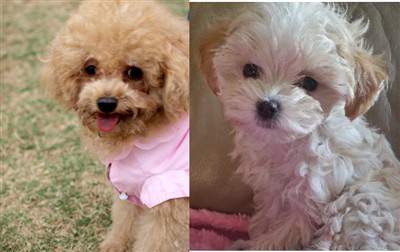
Photo left:
Toy Poodle puppy, when a Poodle is a pup, there is a rounded appearance which makes these 2 dogs look quite similar. If the coat is allowed to grow out a bit, a toy Poodle's muzzle can appear more moderate, like the Maltipoo.
Photo right:
Maltipoo puppy. This is Bella at 4 months old, Photo courtesy of Sophie, Lucy and Albert
Origin
The toy Poodle is thought to have originated in Germany where it was known as the Pudelhund. however the breed was refined in France, so much so that it is the national dog of France. With references to the Poodle in both art in literature dating back to the 1400’s, this breed has a rich history. The Poodle was very popular in Spain during the 18th century. Though now a companion dog, the Poodle was originally bred for water retrieval and hunting. It is believed that the standard size is the oldest, original size and as time went on, the dog was bred down to be smaller, thus resulting in the mini, medium (outside of the US) and toy.
The Maltipoo is a hybrid dog, being either a cross of a toy or mini Poodle and a Maltese (1st generation) or is produced by pairing two Maltipoos. While many breeds were bred for specific purposes, for example the toy Poodle was bred for hunting and water retrieval, Bloodhounds were bred for tracking and the Yorkshire Terrier was originally a ‘ratter’ (a dog used in large factories and warehouses to chase and kill rats and other vermin), the purpose of many other breeds, including the Maltipoo is to be a companion dog. In other words, developed solely for the purpose of being a pet.
This is true not only of designer dogs like the Maltipoo and Shihpoo, but also of purebreds such as the Maltese, Japanese Chin, Skye Terrier and many others.
The listed country of origin for the Maltipoo, should he become an accepted purebred someday, is unknown, though it does lean towards the United States. It will ultimately depend on which country has the most enthusiasts, parent clubs and number of dogs registered.
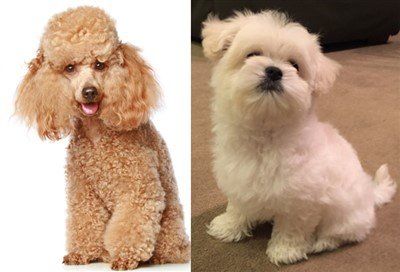
Photo left:
The toy Poodle is capable of having a very narrow snout.
Photo right:
The Maltipoo's snout most often resembles the Maltese, more rounded and moderate. Simba, Photo courtesy of the Reyna-Salazar Family.
Head and Face Shape Comparison
When it comes to face shape, including muzzle, this is where you will see a big difference in Maltipoo dogs VS toy Poodles. Most Maltipoos will have much more of the Maltese appearance here. Poodles have long, narrow snouts as described in the standard as ‘'long, straight and fine, with slight chiseling under the eyes'. This said, some Poodle breeders produce toys with a more rounded appearance. The very narrow snout that you see in the image (left, top on mobile) is that which you will find in the show ring. Contrasting to that, the majority of Maltipoo dogs have a more rounded appearance. The toy Poodle’s skull is moderately rounded, with a slight but definite stop. The Maltipoo has a moderate stop.
Ear set
is similar, though this is not always apparent due to how the hair is shaped. Clips on a toy Poodle can drastically alter his perceived appearance. The toy Poodle’s ears “hang close to the head, set at or slightly below eye level” but
will be larger than the Maltipoo ear, which is low set though often hanging close to the head, as well.
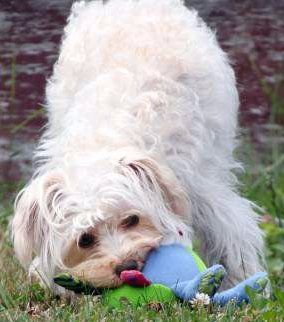
Woof, rufff, rrrr...grrr... UMPHF!"
Translation:
"Tweets for treats...? ... or share for... ahh... a pear???
Well, you get the gist! Show me some love & share this page before you read on."
Differences in Coat
This is one of the most interesting features when comparing a Maltipoo to a toy Poodle. Do note that for this, we are going to talk about the actual texture and lay of the coat and not color (that will be covered in the next section).
Curl
- Most notable is the curly coat of the Poodle. Hair curl is caused by a mutation in the KRT71 gene. Though, do not let the word ‘mutation’ throw you off, lots of breeds have this! For the Poodle, the mutation in the KRT71 gene is fixed (always there). For other breeds, including the Boykin Spaniel, the Kuvasz and the Chihuahua, among others, it is a variant (may be there).
DNA testing can look for this, by looking to the C allele. If it is dominant, it will be C/C (curly – and being dominant, the curl would be passed to litters). If it is C/c, the dog has both dominant and recessive alleles (if bred, either curly or straight may be passed on) and if it is c/c the dog is negative for the hair curl allele (and does not carry the gene at all, so if bred could not produce puppies with a curled coat).
When it comes to the Maltipoo, since there are Maltese genes at play and Poodle genes at play, the coat may be straight, curly or somewhere in between. If there is a wave, this does mean that curl gene is present. However, the straight hair of the Maltese has its influence (a wave or curl is considered a fault), thus the curl is weak, producing soft waves. When a Maltipoo is a 2nd or 3rd generation, the coat will start to become straighter, as the Poodle has less influence.
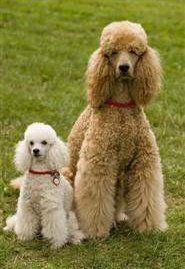
Poodles of all varieties have curly coats
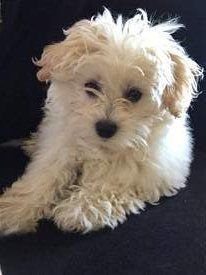
Some Maltipoos will have cute little curls. Bailey at 3 months,. photo courtesy of Hillary
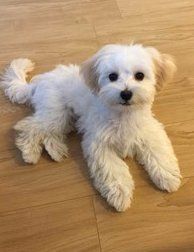
And others will have more of a wave. Brie, at 6 months old
Photo courtesy of Yerim Lee
Texture
- The comparison of coat denseness and texture is interesting as well. Poodles have very dense coats; though they are a single coated breed, the hair is considered to be naturally ‘harsh texture’. This is a result of the breed’s history and develop as a water retrieval dog. The Maltipoo, however, does not often take on this quality. The majority of Maltipoo dogs will have coat texture much more similar to the Maltese, which also has a single coat, but it is of very fine texture.
Length
– Toy Poodles cannot grow long coats due to the curl; without clipping, the coat does not grow noticeably longer, but instead will grow thicker. Opposite to that, Maltipoo dogs that have a wavy coat can indeed grow their coat long.
Shedding
–Contrary to popular belief, there is no such thing as a ‘non-shedding’ dog. It simply cannot exist. All dogs shed (even humans shed!). However, both the toy Poodle and Maltipoo are very light shedders. The coat of each is always in a process of growth, stall and fall. So, the coat will shed as part of the normal growth cycle of hairs, however it is light enough that it is never seen as a problem since hairs are fine as opposed to thick fur that some other breeds have.
Hypoallergenic?
– While everyone from breeders to celebrities to show handlers and those speaking on behalf of presidents will say that some breeds are hypoallergenic, this simply is not true. It’s not true for the Poodle, nor is it true for the Maltipoo. No dog can be 100% hypoallergenic, since this implies that the dog cannot cause allergies. There are lots of people who are either allergic to a dog’s dander (and all dogs produce dander, regardless if they have hair or fur) and others are allergic to a dog’s saliva. Though dogs like the Poodle and Maltipoo will shed very little compared to other breeds and they both have single-layer coats, thus producing fewer allergens, a human may be allergic to either.
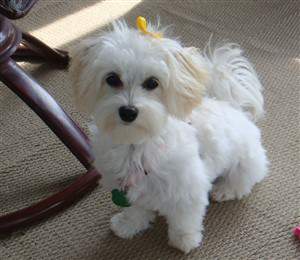
Chloe, a 6 year old Maltipoo
Photo courtesy of Rick Boynton
Size Differences
Both Maltipoo and toy Poodles are considered to be in the Toy size class. The toy Poodle is classified as such based on height, not weight. Any Poodle 10 inches or under will be a toy. Mini’s are 10 to 15 inches. Though weight is not given in the standard, most toy Poodles will fall between 6-9 lbs. (2.72-4.08 kg), making them a rather small dog.
The Maltipoo, on the other hand, has a much wider range of size; both height and weight. Though the toy Poodle is small, if a mini Poodle is in the bloodline, since these dogs can be found up to 17 lbs. (7.71 kg), the Maltipoo can be larger. Maltipoo dogs are typically in the 8 to 10 pound range (3.62 to 4.53 kg) and they can grow to be as large as 12 lbs. (these are often the ones that have a miniature Poodle as a parent). Therefore, the majority of Maltipoos will be slightly larger than toy Poodles. This said, Maltipoos would never be considered anything other than a toy sized dog, since the largest of all toy breeds is the Pug, with a weight of 14 to 18 lbs. (6.35 to 8.16 kg) and just about all Maltipoos fall under this size.
Differences in Color
When looking at a Maltipoo versus a toy Poodle, both can be found in an array of colors. Any color at all that is present in Poodles is present in Maltipoos. No color cannot be passed down. Of course, since the other contributing breed to the Maltipoo is the Maltese, and his coat is often pure white (some are lemon, though this is not desired), this of course, also affects coat color.
Though, another point that must not be left out, is the fading factor. Poodles can, and often do, have a fading gene. It causes the coat to fade or ‘clear’ as the dog matures. The coat lightens noticeably.
Now, since a Maltipoo may already have a lighter coat than a Poodle due to the white of the Maltese (though this is not always the case) and you add to that the possible fading gene which can cause dramatic coat color changes, you can see why many Maltipoo dogs have lighter coats than Poodles, and particularly at the puppy stage, before any clearing is done. This said, dark and strong-color coated Maltipoos and Poodles do exist, though they are rare, such as solid black or dark red.
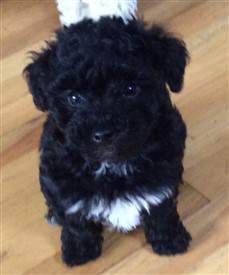
Rare!
This Maltipoo (for now) holds a strong black color. This is not often seen, since most Maltipoos have lighter coats then the Poodle. This is 8 week old Blue, photo courtesy of Sharon Lundgren
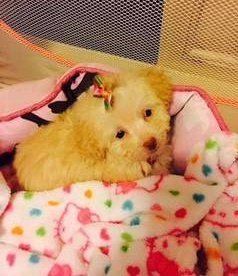
Apricot
- While this color will most likely fade as the pup matures, this is a wonderful example of how the Maltipoo can have the apricot Poodle coloring. Arabelle, at 8 weeks old. Photo courtesy of Theresa Frye
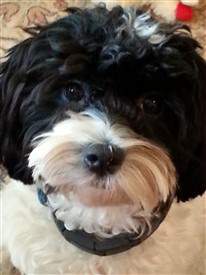
Parti
- The Poodle genes are at play here. This Maltipoo is a black & white parti. Cooper is seen here at 10 months old, so it remains to be seen if the coat will lighten. Photo couresty of Dave & Debbie Morris
Personality Comparisons
Whenever you read about a breed’s temperament, you’ll want to remember that this speaks to generalizations; each dog has his own unique personality. And while you can look to expected character traits, there are outliers. In addition, how a dog is raised (training, if there is an understanding of proper hierarchy, home environment, etc.) plays a huge role in shaping a dog’s disposition.
In general, toy Poodles
are a very active, energetic breed. There is a lot of vigor tucked into a small package. Puppies are quite hyper and adults may be as well. While they are small enough to comfortably live in just about any sized home, most Poodles require a good amount of exercise to release pent-up energy. If not, there may be excessive barking and/or destructive behavior. They are also good watch dogs, as they will not hesitate to be vocal. Typically, Poodles get along well with other dogs and even cats. In regard to small children, a Poodle may try to be dominant and/or there can be some jealousy issues. This is a very intelligent breed, ranked at #2 by Dr. Stanley Coren in the Intelligence of Dogs (understanding of new command with fewer than 5 repetitions.
In general, Maltipoo dogs
are a bit more laid back than toy Poodles. The temperament of the Maltese has an influence here, with its incredible sweet nature and amiable, friendly manner. This is an alert breed, that closely bonds with his humans. Maltipoos are quite smart, get along well with other dogs (though may be intimidated by larger dogs), do well with cats and are often due exceptionally well with children of all ages.
Health
Toy Poodles are most prone to:
• Addison's disease – Abnormal functioning of the adrenal gland that helps regulate normal body functions.
• Chronic Active Hepatitis – A liver disease
• Cushings disease - An increase in cortisone due to a benign tumor of the pituitary gland.
• Epilepsy
• Hip Dysplasia – Abnormal growth of the hip joint and socket
• Hypothyroidism- Malfunctioning thyroi
• Legg-Calve-Perthes - Degeneration of the head on the femur bone
• Patellar Luxation – Slipped knee cap
• Von Willebrand's disease (vWD) – An inherited bleeding disorder
Maltipoo dogs:
One of the benefits of hybrid dogs like the Maltipoo is that hybrid vigor
may lead to a healthier dog, saving him from some of the conditions that can affect purebreds. Though, the concept of hybrid vigor is often wildly exaggerated due to misinformation. It does not mean that a dog will be safe from all health conditions. It does, however, mean that some issues will be seen far less frequently. So far, studies have proven that the following is seen less often in hybrid dogs: Aortic stenosis, chronic skin issues seen with allergies, bloat, cataracts, dilated cardiomyopathy, elbow dysplasia, hypothyroidism, Intervertebral disk disease and portosystemic shunt.
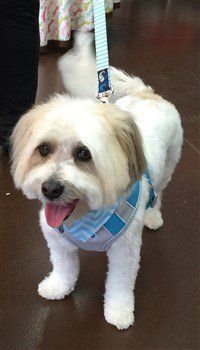
Shiloh, at 4 years old
Photo courtesy of the Perry Family
For this reason, the Maltipoo is still vulnerable to the conditions that Poodles is prone to have, as well as the Maltese. Other health concerns include but are not limited to:
• Collapsed Trachea
• Dental Problems
Summary
Both toy Poodles and Maltipoos make for fantastic pets. Being of small stature, they fit well in just about any sized home and are easy to take along in the car, to run errands, etc. Being very minimal shedders, both are easy to maintain, though the curly, dense coat of the Poodle often requires frequent clippings and more upkeep than the more casual, wavy coat of the Maltipoo.
In general, toy Poodles may be a bit more hyper than Maltipoos, though both have a good amount of energy for play and will eagerly spend time with their human doing all sorts of activities. Poodles may be a tad more vocal than Maltipoos, though a bit easier to train. When all is said and done, both are beautiful, amazing dogs in their own right.
Things to do now:
Become a free Member
(if you are not already a Member) so that you'll receive a friendly reminder we add new pages of information to this site. You can also suggest a topic for us to write about or ask a question about your Maltipoo.
Browse through the Maltipoo Specialty Shoppe
- Every top recommended product specifically for the Maltipoo.
Request your copy of the PetMaltipoo eBook
- The most comprehensive Maltipoo care book that exists. This is a 'must have' book for all Maltipoo owners.
Popular Pages:
Red Maltipoos
- Due to fading genes, this color is rare and it is very beautiful. See explanations and some cute photos.
White Maltipoos
- Snowy white without any other color is quite adorable. Since the Maltese is pure white, this is one of the typical colors of the Maltipoo dog, though some secondary coloring from the Poodle's genes may grow in as the pup matures.

